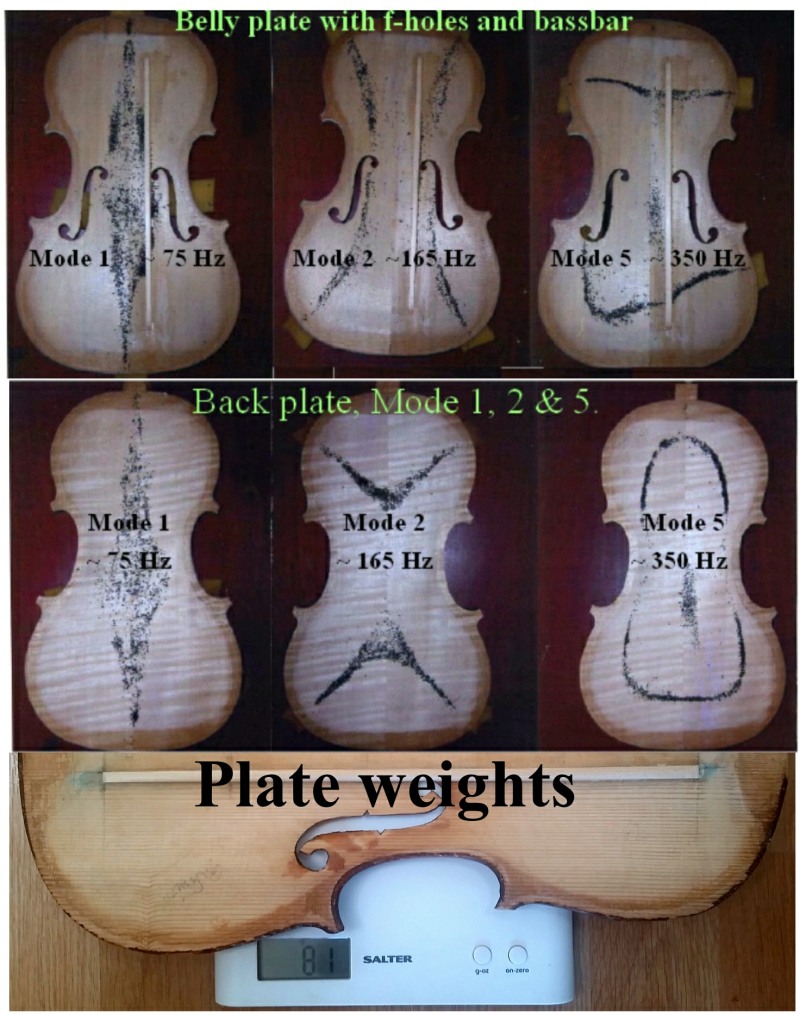|
A remarkably lady, Carleen Maley Hutchins (photo right) co-founded this Catgut Acoustical Society (CAS) nearly 50 years ago, and I remember her first article well: my mum showed it to me in the early 60’s when it was printed in Scientific American , Nov 1962. You may be able to get back-copies if you do a web search. A later article by her in 1981 could be found on a Russian website and the which I’ve put into a .pdf file here. The excitement of that approach stayed with me. Carleen died in Aug ‘09 at the grand age of 98, and her obituary was published in the LA Times. Carleen Maley Hutchins (photo right) co-founded this Catgut Acoustical Society (CAS) nearly 50 years ago, and I remember her first article well: my mum showed it to me in the early 60’s when it was printed in Scientific American , Nov 1962. You may be able to get back-copies if you do a web search. A later article by her in 1981 could be found on a Russian website and the which I’ve put into a .pdf file here. The excitement of that approach stayed with me. Carleen died in Aug ‘09 at the grand age of 98, and her obituary was published in the LA Times.
There is a moving video on youtube of her talking about violins, violas and w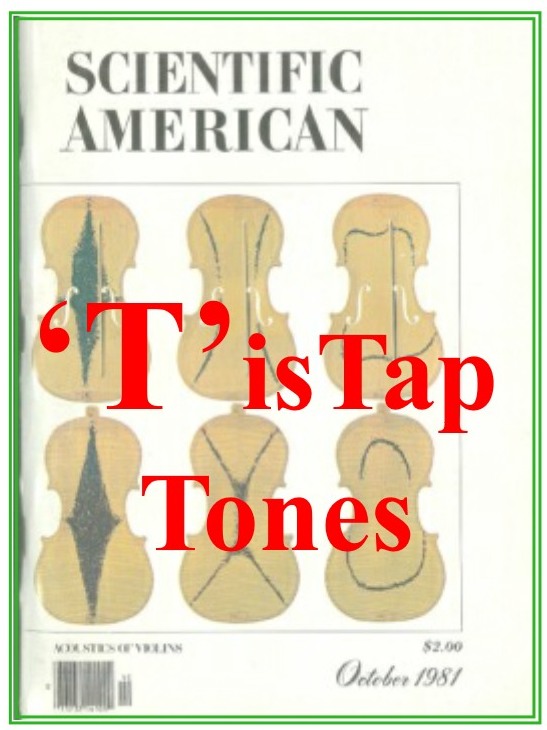 hat she did, and here is an interview with her too. What a lady! hat she did, and here is an interview with her too. What a lady!
Traditionally, violin makers ‘tune’ the front and back plates around an ‘F’ to ‘F sharp’ tap tone**. Tap-tone methods has been around for well over a hundred years (see footnote) and probably very much longer. Unfortunately factory-made fiddles, all that many of us can afford, have never even heard of ‘tap tones’ or even suffered much care in manufacture. Indeed many of these fiddles have so much wood in the back that if burned they could heat a small home for an evening.
The best article on the web I have found is a one by Alan Carruth dating from 1992. It pre-dates the home computing revolution, but he was trained by Carleen Hutchins and has a gift for writing, so have a look at this article called “Free Plate Tuning: Part II, Violins”.
Quick & free frequency measurements with a smart-phone or a home computer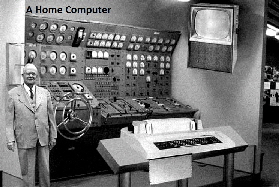
What has changed over the last 10 or 20 years is that the home computer (+ mic.) - and recently the smart-phone have made available to us methods for measuring tap tone and violin body resonance frequencies very, very quickly - and for no cost.
You can use your smart phone with the right app such as AudioTool, Spectroid, or Audizr, or Spectrum RTA: there are over a dozen free Audio Analyser [FFT] apps av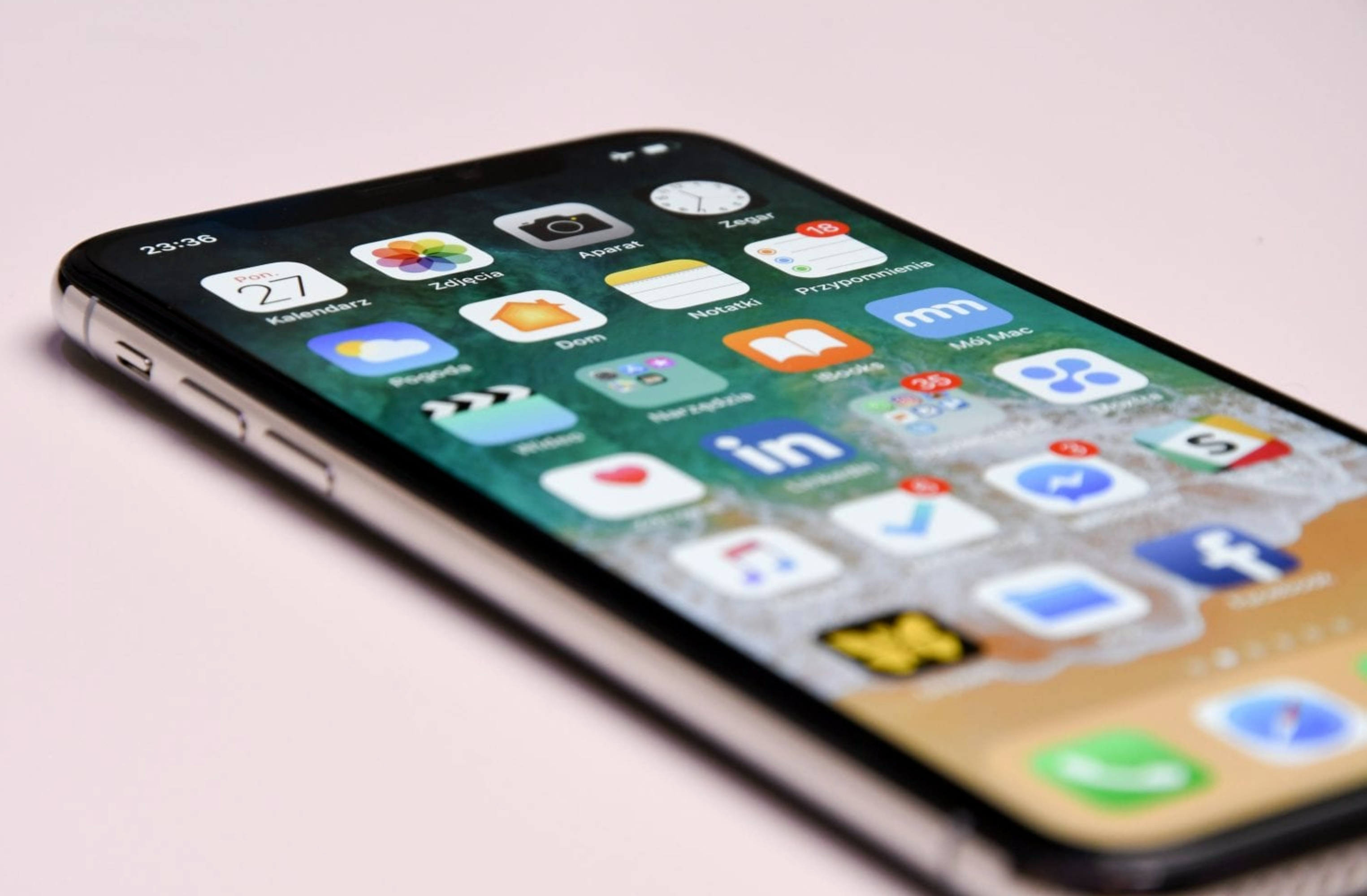 ailable to do it! It takes me a minute or so to measure the tap tones of a violin plate: it is particularly quick to use a smart-phone. You just put it on a desk edge with microphone outwards, set the “Max. hold” function and and tap the violin plate near it - and that’s it. ailable to do it! It takes me a minute or so to measure the tap tones of a violin plate: it is particularly quick to use a smart-phone. You just put it on a desk edge with microphone outwards, set the “Max. hold” function and and tap the violin plate near it - and that’s it.
Carleen Hutchins would need perhaps an hour or more with specialist equipment, and Signor Antonio Stradivari? Well, he needed a very well trained ear and maybe a a ‘standard’ wooden rod or mono-cord to tap for comparison. A good ear helps, but is not essential.
At first I found that Carleen’s methods of adjusting the tap tones of front and back to an octave (2:1 ratio of Modes 5 and 2 frequencies in both) did not seem to always produce really good fiddles: but they sounded better than before.
I think it's because the wood for factory fiddles, especially the fronts, is not good, low density, prime-choice wood and you have to strip the violin right down to its parts!
Makers can pay as much for the wood as some people might pay for a violin outfit. Try Lemuel Violins (formerly Luscombe Violins Inc) for wood: a family-owned retail business in Mt. Elgin, Ontario, Canada, or Touchstone Tonewoods in the UK.
Simeon Chambers (in Colorado, USA) has an excellent range of wood at reasonable prices and plate thickness maps for sale too. He suggests the light Englemann spruce for bellies, with a density (specific gravity) of 0.34 to 0.38 gm./cc., which is much less than than normal European spruce at 0.45, but European makers often prefer Bosnian Spruce. He also recommends, and many makers insist that the back plate maple has a density no more than 0.6 (gm.per cc). 0.65 gm per cc. is normal. It needs to be light and strong! Simeon has alas stopped cutting this top-grade wood now (early 2017), but there are some items left.
Main violin body resonances: key to good tone.
To get a violin to sound good you need to get the 6 key body resonances below 600 Hz in the right place and these resonances need to be in ‘harmony’ with each other.
1) The air inside the instrument resonates through the f-holes, so it has to the right internal air volume and the f-holes need to be the right size or area. This gives strength to the G-string’s sound. (This is the Helmholtz resonance)
2) The air column along the length between the end blocks resonates rather like a church organ, so the body needs to be the right length,
3) the arching and channel around the violin needs to be the right shape, and
4) the tap tones or speed of sound along and across the top (belly) and back plates needs to be within tight limits. These give strength and quality to the A-string's sound.
5) The plates need to be as light as you can make them for sound volume - but with tap tones not too low (see 4) above.
6) the bridge and sound-post must be fitted correctly so the violin talks, and so the higher frequencies, all of them, and there are lot above 600 Hz, can come out.
There is an awful lot to get right.
History: ways of making a violin
In making or modifying a violin or viola for good or better tone you can choose one of a number of methods. These are, in historical sequence:-
- Use craftsmanship! Get help, get trained, get experience, and make your first dozen violins. There is no substitute for knowledge, craftsmanship and for experience, not least in choosing your wood.
- There are many plate thickness maps available, and there are some available free on the web. They kind of work, but most plates need to be thicker or thinner than the map, as every bit of wood has different elasticity so I recommend ‘tuning the plates’ too! Dominic Excell’s articles on a First Violin does not use plate tuning (but I’m talking to him!).
- If you do choose to use wood tap-tone tuning methods, then adjust the traditional Tune Mode 5 (Ring tone) with the back Mode 5 sounding F#, and the front at F as a ‘raw’ plate before f-holes are cut. This ‘F’ later becomes F# and even G with f-holes, bassbar fitted and varnished . The tap tone must be a full, true ring, the best you can get. Mode 2 frequency ‘floats’, and the plate’s weight is ignored. Typically, allied with good practice, very good wood and experience it works well**.
- use the ‘CAS’ method: Tune Mode 5 and Mode 2 to be an octave apart (Mode 5 = 2 x Mode 2). This is Carleen Maley Hutchins’ (or the CAS***) method. It works well if you are choosing the best wood. Modes 2 & 5 frequencies of front and back should be equal.
- Dr. Nigel Harris’s came up with a method Tune Modes 5 and Mode 2 and take the violin plate’s weight into account by making the ‘plate stiffness’ proportional to the plate’s weight. Dr. Harris may achieve tonal repeatability using his ‘stiffness’ method but my data shows that heavy plates need to be made with significantly higher not lower tap tones!
- I did suggest using his ‘stiffness figure’ method for years on this site. I apologise profusely to anyone who used it, it is simply wrong and unnecessary.
- An excellent book by Patrick Kreit “The Sound of Stradivari” was published in 2011. Dr.Harris’ work on plate Stiffnesses is not compatible with Patrick Kreit’s work. I have found that light plates are much better, and so far as I know Patrick’s book explains the only method to produce the lightest plate from any given piece of wood.
Theory: Dr. Nigel Harris and Patrick Kreit
I have concentrated on getting the tap tones of the plates where I want them, but tap-tones are just a part of the whole: the air volume, f-hole area, arching, body length, sound-post and bridge must all be right too.
About five years ago I came across 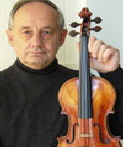 an article by Dr. Nigel Harris (interviewed here!) that seemed to be the next step in the elusive connection between the tap tones of a violin's plates, its playability (the violin's ease of bowing), and a real quality and depth of tone. In addition, as Dr. Harris puts it, it can make a given tone reproducible, violin to violin. an article by Dr. Nigel Harris (interviewed here!) that seemed to be the next step in the elusive connection between the tap tones of a violin's plates, its playability (the violin's ease of bowing), and a real quality and depth of tone. In addition, as Dr. Harris puts it, it can make a given tone reproducible, violin to violin.
Dr. Harris (right) who sells some seriously good, pricey violins at Harris & Sheldon (violin.co.uk) links the plates’ Mode 5 (called the ring tone), Mode 2 (the ‘X’ Mode), and the weight of the plates into what he calls each plates’ ‘Stiffness Figure’. His work on 1000 + violins and his rather complex theory shows that if the front and backs have a similar ‘stiffness’ then a good fiddle can result.
Patrick Kreit’s book “The Sound of Stradivari” has been a revelation on how the violin plates’ tap tones are linked directly to the finished violin body's key body resonances, the ones that make it work well as a violin!
So I have built on the work of Carleen Hutchins, Dr. Harris and Patrick Kreit to provided a theoretical (or perhaps empirical) framework and route to show you can make excellent-sounding violin, that is to made the construction of a fine first violin a real possibility.
Make it as simple as possible.
I have modified, simplified and explained how to do it here, and provided the ‘tools’ to do it: my objective is that apart from using a computer or smart-phone, a ruler and some kitchen scales to measure a violin's parts as you go along, you should not need a calculator. So I have provided charts and tables to do it.
Quick results: Plate Tuning for Dummies!
On my page called “Plate Tuning 4 Dummies” there is the information for those people who want quick results and rules of thumb to make a good fiddle first time round, but you really need to check and adjust the tap tones and measure the weights of the partly assembled and even the fully assembled instrument to get a really good one. There are no short cuts, because every piece of wood is different.
I have 8 or 10 beautiful, well-made violins by amateurs that look really wonderful on the outside, but play like the cheap school fiddles - simply because they did not have their plates tuned at all!
So have a a glance here for the basics: but you will still need to know how to hear and or record a tap tone on the “ Mode & tuning plates” page of course!
What this is all about? Make a $150 violin sound like a $1500 violin
So this web site is all about just how to measure tap tones and weights to help you make a new violin, or to modify an existing and poor-sounding $100 factory fiddle to get it to play and sound like a $1500 violin.
So have a look at the various pages here. In particular, have a look at how to easily measure tap tones. I’ll show too the various stages of how I modified some poorly made instruments as examples. You can’t do much damage to a £40 ($60) violin: at worst it’s £40 of experience. But Warning: but do not do this on your Concert Stradivarius!
Feedback: tell me what you think, and tell me your experiences.
Let me know what you think of this site and its contents: violin plate tuning seems to evoke strong emotions in luthiers ...... so email me now at webmaster@platetuning.org ! It’s all work in progress, so I’ll include your comments, but no promises though.
-------------------------------------------------------------------------------
Footnote ** : F# is 370 Hz, F (natural) is 349.2 Hz, and E is 329.6 Hz. The reference here is to Ed. Heron-Allen’s book on violin making of 1885-6. Believe it or not he refers to Modes 2 and 5 and ‘nodal lines’ on p.133, and tells the reader how to make them visible using sand and a bow! Yes, that's from 125 years ago.
Footnote 1) Many authors (Hutchins, Molin, Moral, Schleske) use the terms “eigenmodes” or eigenfrequencies”: they are just body resonances of the violin corpus, in part or finished state.
Footnote 2): In particular the B1-, B1+ and CBR body resonances. Since the two coupling frequencies are present on the finished violin, they are in fact “eigenmodes” or “eigenfrequencies” 1 of the whole, finished violin. So thay can be adjusted or set at the intermediate stage during the building of a violin, i.e. with just one plate at a time glued to the bouts or garland. The two Coupling frequencies then control and set the key B1-, B1+ and the CBR (C2) body resonances. See also the page Resonances of the Violin body.
|
